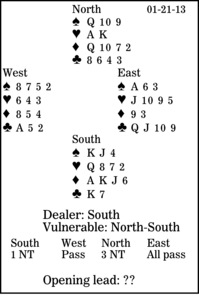Bridge column, January 21: When to lead high or low

In bridge, we think left and right when considering our opponents. We think low and high when deciding which card to lead from a given holding (or whether to play low or high when following suit). This week, let's look at the single most important rule for defenders: When you lead from length, if you lead a low card, you guarantee an honor in that suit; without an honor, lead an unnecessarily high card. (There is one clear exception to that rule, which we will look at later this week.)
Today's deal provides a good example. What should West lead against three no-trump?
The auction is simple and quantitative.
West should lead the spade eight, the high card denying an honor in the suit. Then how should East defend?
Can the eight be fourth-highest from length and strength? Apply the Rule of Eleven. Eight from 11 is three, but East can see four spades higher than the eight on the board and in his hand. So, the eight must be top of nothing. And since South has the spade king and jack, it is pointless to plug away at that suit.
Instead, East should win the first trick with his spade ace and shift to the club queen. Here, that works well, netting the first five tricks for the defenders.
Always read partner's lead, deciding what he has led from; in particular, is he weak or strong in that suit?
** ** **
COPYRIGHT: 2013, UNITED FEATURE SYNDICATE
DISTRIBUTED BY UNIVERSAL UCLICK FOR UFS

